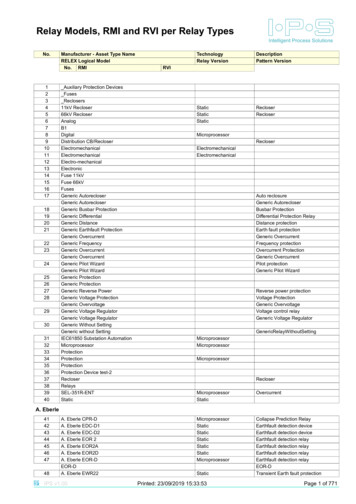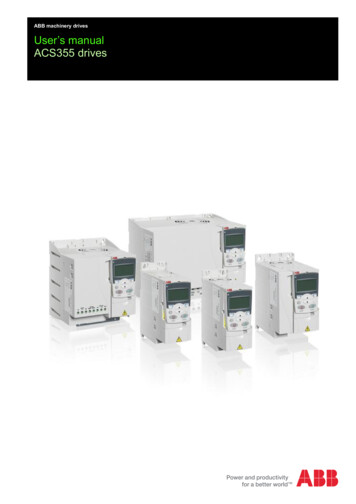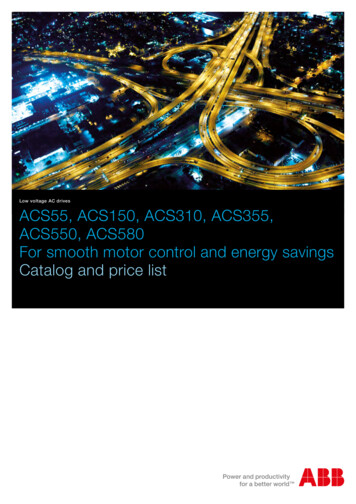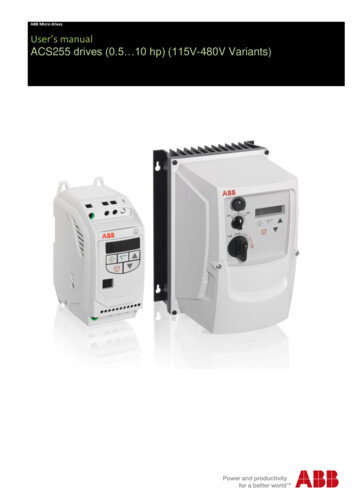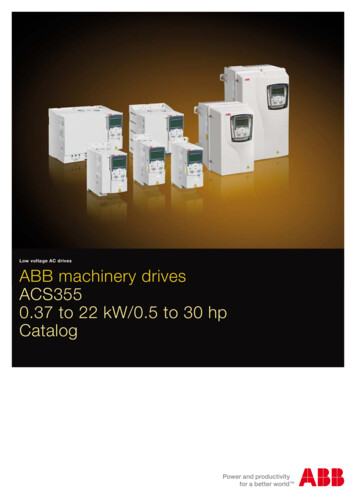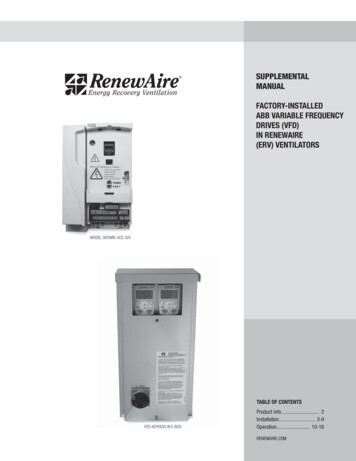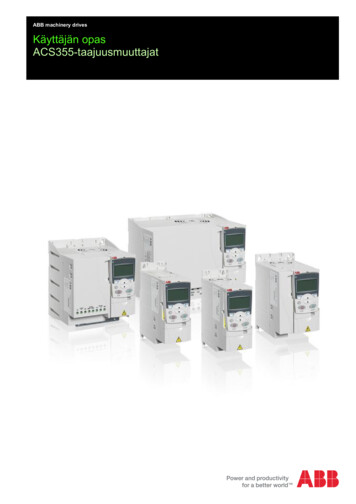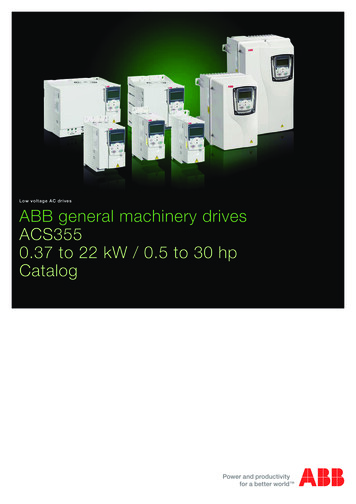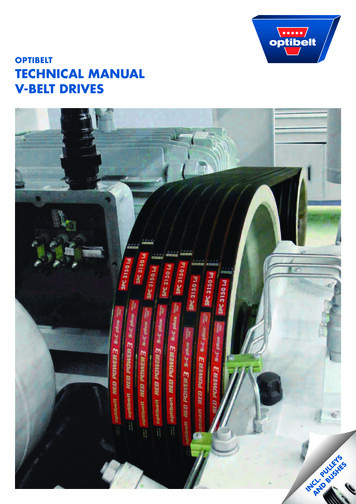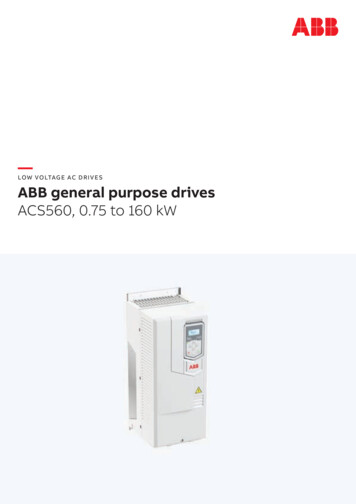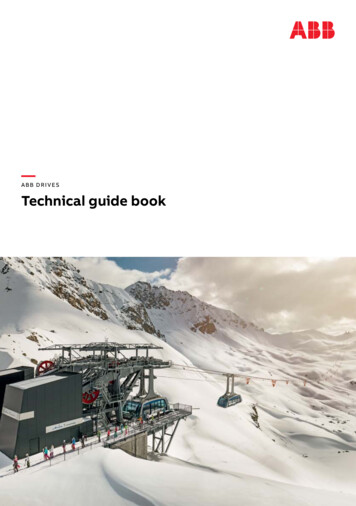
Transcription
—ABB DRIVESTechnical guide book
ABB drives - Technical guide book Copyright 2016 ABB. All rights reserved.Specifications subject to change without notice.3AFE64514482 REV I 16.2.2016Technical guide book I ABB drives 3
4 ABB drives I Technical guide book
Contents1. Direct torque control explains what DTC is; why and how ithas evolved; the basic theory behind its success; and the featuresand benefits of this new technology.12. EU Council Directives and adjustable speed electricalpower drive systems is to give a straightforward explanationof how the various EU Council Directives relate to power drivesystems.23. EMC compliant installation and configuration for a powerdrive system assists design and installation personnel whentrying to ensure compliance with the requirements of the EMCDirective in the user’s systems and installations when using ACdrives.4. Guide to variable speed drives describes basics of differentvariable speed drives (VSD) and how they are used in industrialprocesses.5. Bearing currents in modern AC drive systems explainshow to avoid damages.3456. Guide to harmonics with AC drives describes harmonicdistortion, its sources and effect, and also distortion calculationand evaluation with special attention to the methods for reducingharmonics with AC drives.67. Dimensioning of a drive system. Making dimensioningcorrectly is the fastest way of saving money. Biggest savings canbe achieved by avoiding very basic mistakes. These dimensioning basics and beyond can be found in this guide.78. Electrical braking describes the practical solutions availablein reducing stored energy and transferring stored energy backinto electrical energy.9. Guide to motion control drives gives an overview of highperformance drives and motion control.10. Functional safety guide introduces the Machinery Directiveand the standards that must be taken into account when designing a machine, in order to ensure operational safely.Technical guide book I ABB drives 58910
ABB drivesTechnical guide No. 1Direct torque control the world’s most advancedAC drive technology
2Direct torque control Technical guide No. 1
Technical guide No. 1Direct torque control - the world’s mostadvanced AC drive technology1 Copyright 2011 ABB. All rights reserved.Specifications subject to change without notice.3AFE58056685 REV C 6.6.2011Technical guide No. 1 Direct torque control3
4Direct torque control Technical guide No. 1
ContentsChapter 1 - Introduction .71General .7This manual’s purpose .7Using this guide .7What is a variable speed drive? .8Summary .8Chapter 2 - Evolution of direct torque control .8DC motor drives .9Features .9Advantages .9Drawbacks .10AC drives - Introduction .10AC drives - Frequency control using PWM .11Features .11Advantages .12Drawbacks .12AC drives - Flux vector control using PWM .12Features .12Advantages .13Drawbacks .13AC drives - Direct torque control .14Controlling variables .14Comparison of variable speed drives .15Chapter 3 - Questions and answers .17General .17Performance .18Operation .24Chapter 4 - Basic control theory .28How DTC works .28Torque control loop.29Step 1 Voltage and current measurements .29Step 2 Adaptive motor model .29Step 3 Torque comparator and flux comparator .30Step 4 Optimum pulse selector .30Speed control .31Step 5 Torque reference controller .31Step 6 Speed controller .31Step 7 Flux reference controller .31Chapter 5 - Index .32Technical guide No. 1 Direct torque control5
6Direct torque control Technical guide No. 1
Chapter 1 - IntroductionGeneralDirect torque control - or DTC - is the most advanced AC drivetechnology developed by any manufacturer in the world.This technical guide’s purposeThe purpose of this technical guide is to explain what DTC is;why and how it has evolved; the basic theory behind its success;and the features and benefits of this new technology.While trying to be as practical as possible, this guide does requirea basic understanding of AC motor control principles.It is aimed at decision makers including designers, specifiers,purchasing managers, OEMs and end-users; in all markets suchas the water, chemical, pulp and paper, power generation, material handling, air conditioning and other industries.In fact, anyone using variable speed drives (VSD) and who wouldlike to benefit from VSD technology will find this technical guideessential reading.Using this guideThis guide has been designed to give a logical build up as towhy and how DTC was developed.Readers wanting to know the evolution of drives from early DCtechniques through AC to DTC should start at chapter 2 (page 8).For those readers wanting answers about DTC’s performance,operation and application potential, please go straight to chapter3 (page 17) Questions and answers.For an understanding of DTC’s basic control theory, turn topage 28.Technical guide No. 1 Direct torque control71
Chapter 2 - Evolution of direct torquecontrolWhat is a variable speed drive?To understand the answer to this question we have to understandthat the basic function of a variable speed drive (VSD) is to controlthe flow of energy from the mains to the process.Energy is supplied to the process through the motor shaft. Twophysical quantities describe the state of the shaft: torque andspeed. To control the flow of energy we must therefore, ultimately,control these quantities.In practice, either one of them is controlled and we speak of“torque control” or “speed control”. When the VSD operatesin torque control mode, the speed is determined by the load.Likewise, when operated in speed control, the torque is determined by the load.Initially, DC motors were used as VSDs because they could easily achieve the required speed and torque without the need forsophisticated electronics.However, the evolution of AC variable speed drive technologyhas been driven partly by the desire to emulate the excellentperformance of the DC motor, such as fast torque response andspeed accuracy, while using rugged, inexpensive and maintenance free AC motors.SummaryIn this section we look at the evolution of DTC, charting the fourmilestones of variable speed drives, namely:––––DC motor drivesAC drives, frequency control, PWMAC drives, flux vector control, PWMAC drives, direct torque control9111214We examine each in turn, leading to a total picture that identifiesthe key differences between each.8Direct torque control Technical guide No. 1
Evolution of direct torque controlDC motor drives1Figure 1: Control loop of a DC motor driveFeatures– Field orientation via mechanical commutator– Controlling variables are armature current and field current,measured DIRECTLY from the motor– Torque control is directIn a DC motor, the magnetic field is created by the current throughthe field winding in the stator. This field is always at right angles tothe field created by the armature winding. This condition, knownas field orientation, is needed to generate maximum torque. Thecommutator-brush assembly ensures this condition is maintainedregardless of the rotor position.Once field orientation is achieved, the DC motor’s torque is easilycontrolled by varying the armature current and by keeping themagnetising current constant.The advantage of DC drives is that speed and torque - the twomain concerns of the end-user - are controlled directly througharmature current: that is the torque is the inner control loop andthe speed is the outer control loop (see Figure 1).Advantages– Accurate and fast torque control– High dynamic speed response– Simple to controlInitially, DC drives were used for variable speed control becausethey could easily achieve a good torque and speed responsewith high accuracy.Technical guide No. 1 Direct torque control9
Evolution of direct torque controlA DC machine is able to produce a torque that is:– Direct - the motor torque is proportional to the armturecurrent: the torque can thus be controlled directly andaccurately.– Rapid - torque control is fast; the drive system can havea very high dynamic speed response. Torque can bechanged instantaneously if the motor is fed from an idealc u r re n t s o u rc e . A v o l t a g e f e d d r i v e s t i l l h a s a f a s tresponse, since this is determined only by the rotor’selectrical time constant (ie, the total inductance andresistance in the armature circuit)– Simple - field orientation is achieved using a simplemechanical device called a commutator/brush assembly.Hence, there is no need for complex electronic controlcircuitry, which would increase the cost of the motorcontroller.Drawbacks––––Reduced motor reliabilityRegular maintenanceMotor costly to purchaseNeeds encoder for feedbackThe main drawback of this technique is the reduced reliabilityof the DC motor; the fact that brushes and commutators weardown and need regular servicing; that DC motors can be costlyto purchase; and that they require encoders for speed and position feedback.While a DC drive produces an easily controlled torque from zeroto base speed and beyond, the motor’s mechanics are morecomplex and require regular maintenance.AC drives - Introduction––––––Small sizeRobustSimple in designLight and compactLow maintenanceLow costThe evolution of AC variable speed drive technology has beenpartly driven by the desire to emulate the performance of theDC drive, such as fast torque response and speed accuracy,while utilising the advantages offered by the standard AC motor.10Direct torque control Technical guide No. 1
Evolution of direct torque controlAC drives - Frequency control using PWM1Figure 2: Control loop of an AC drive with frequency controlusing PWMFeatures–––––Controlling variables are voltage and frequencySimulation of variable AC sine wave using modulatorFlux provided with constant V/f ratioOpen-loop driveLoad dictates torque levelUnlike a DC drive, the AC drive frequency control techniqueuses parameters generated outside of the motor as controllingvariables, namely voltage and frequency.Both voltage and frequency reference are fed into a modulatorwhich simulates an AC sine wave and feeds this to the motor’sstator windings. This technique is called pulse width modulation(PWM) and utilises the fact that there is a diode rectifier towardsthe mains and the intermediate DC voltage is kept constant.The inverter controls the motor in the form of a PWM pulse traindictating both the voltage and frequency.Significantly, this method does not use a feedback device whichtakes speed or position measurements from the motor’s shaftand feeds these back into the control loop.Such an arrangement, without a feedback device, is called an“open-loop drive”.Technical guide No. 1 Direct torque control11
Evolution of direct torque controlAdvantages– Low cost– No feedback device required - simpleBecause there is no feedback device, the controlling principleoffers a low cost and simple solution to controlling economicalAC induction motors.This type of drive is suitable for applications which do not requirehigh levels of accuracy or precision, such as pumps and fans.Drawbacks––––Field orientation not usedMotor status ignoredTorque is not controlledDelaying modulator usedWith this technique, sometimes known as scalar control, fieldorientation of the motor is not used. Instead, frequency and voltage are the main control variables and are applied to the statorwindings. The status of the rotor is ignored, meaning that nospeed or position signal is fed back.Therefore, torque cannot be controlled with any degree of accuracy. Furthermore, the technique uses a modulator whichbasically slows down communication between the incomingvoltage and frequency signals and the need for the motor torespond to this changing signal.AC drives - Flux vector control using PWMFigure 3: Control loop of an AC drive with flux vector control using PWMFeatures––––12Field-oriented control - simulates DC driveMotor electrical characteristics are simulated - “motor model”Closed-loop driveTorque controlled INDIRECTLYDirect torque control Technical guide No. 1
Evolution of direct torque controlTo emulate the magnetic operating conditions of a DC motor,ie, to perform the field orientation process, the flux-vector driveneeds to know the spatial angular position of the rotor flux insidethe AC induction motor.With flux vector PWM drives, field orientation is achieved by electronic means rather than the mechanical commutator/brushassembly of the DC motor.Firstly, information about the rotor status is obtained by feeding backrotor speed and angular position relative to the stator field bymeans of a pulse encoder. A drive that uses speed encoders isreferred to as a “closed-loop drive”.Also the motor’s electrical characteristics are mathematicallymodelled with microprocessors used to process the data.The electronic controller of a flux-vector drive creates electricalquantities such as voltage, current and frequency, which are thecontrolling variables, and feeds these through a modulator to theAC induction motor. Torque, therefore, is controlled INDIRECTLY.Advantages––––Good torque responseAccurate speed controlFull torque at zero speedPerformance approaching DC driveFlux vector control achieves full torque at zero speed, giving ita performance very close to that of a DC drive.Drawbacks– Feedback is needed– Costly– Modulator neededTo achieve a high level of torque response and speed accuracy,a feedback device is required. This can be costly and also addscomplexity to the traditional simple AC induction motor.Also, a modulator is used, which slows down communicationbetween the incoming voltage and frequency signals and theneed for the motor to respond to this changing signal.Although the motor is mechanically simple, the drive is electrically complex.Technical guide No. 1 Direct torque control131
Evolution of direct torque controlAC drives - Direct torque controlFigure 4: Control loop of an AC drive using DTCControlling variablesWith the revolutionary DTC technology developed by ABB, fieldorientation is achieved without feedback using advanced motortheory to calculate the motor torque directly and without usingmodulation. The controlling variables are motor magnetisingflux and motor torque.With DTC there is no modulator and no requirement for a tachometer or position encoder to feed back the speed or positionof the motor shaft.DTC uses the fastest digital signal processing hardware available and a more advanced mathematical understanding of howa motor works.The result is a drive with a torque response that is typically 10times faster than any AC or DC drive. The dynamic speed accuracy of DTC drives will be 8 times better than any open loopAC drives and comparable to a DC drive that is using feedback.DTC produces the first “universal” drive with the capability toperform like either an AC or DC drive.The remaining sections in this guide highlight the features andadvantages of DTC.14Direct torque control Technical guide No. 1
Evolution of direct torque controlComparison of variable speed drivesLet us now take a closer look at each of these control blocksand spot a few differences.1Figure 1: Control loop of a DCdriveFigure 2: Control loop withfrequency controlFigure 3: Control loop with fluxvector controlFigure 4 Control loop of an ACdrive using DTCThe first observation is the similarity between the control block ofthe DC drive (Figure 1) and that of DTC (Figure 4).Both are using motor parameters to directly control torque.But DTC has added benefits including no feedback device isused; all the benefits of an AC motor (see page 10); and noexternal excitation is needed.Table 1: Comparison of control variablesTechnical guide No. 1 Direct torque control15
Evolution of direct torque controlAs can be seen from table 1, both DC drives and DTC drives useactual motor parameters to control torque and speed. Thus, thedynamic performance is fast and easy. Also with DTC, for mostapplications, no tachometer or encoder is needed to feed backa speed or position signal.Comparing DTC (Figure 4) with the two other AC drive controlblocks (Figures 2 & 3) shows up several differences, the mainone being that no modulator is required with DTC.With PWM AC drives, the controlling variables are frequency andvoltage which need to go through several stages before beingapplied to the motor. Thus, with PWM drives control is handledinside the electronic controller and not inside the motor.16Direct torque control Technical guide No. 1
Chapter 3 - Questions and answersGeneral1What is direct control?Direct torque control - or DTC as it is called - is the very latestAC drive technology developed by ABB and is set to replacetraditional PWM drives of the open- and closed-loop type in thenear future.Why is it called direct torque control?Direct torque control describes the way in which the control oftorque and speed are directly based on the electromagnetic stateof the motor, similar to a DC motor, but contrary to the way inwhich traditional PWM drives use input frequency and voltage.DTC is the first technology to control the “real” motor controlvariables of torque and flux.What is the advantage of this?Because torque and flux are motor parameters that are beingdirectly controlled, there is no need for a modulator, as used inPWM drives, to control the frequency and voltage. This, in effect,cuts out the middle man and dramatically speeds up the responseof the drive to changes in required torque. DTC also providesprecise torque control without the need for a feedback device.Why is there a need for another AC drive technology?DTC is not just another AC drive technology. Industry is demanding more and existing drive technology cannot meet thesedemands.For example, industry wants:– Better product quality which can be partly achieved withimproved speed accuracy and faster torque control.– Less down time which means a drive that will not trip unnecessarily; a drive that is not complicated by expensivefeedback devices; and a drive which is not greatly affectedby interferences like harmonics and RFI.– Fewer products. One drive capable of meeting all applictionneeds whether AC, DC or servo. That is a truly “universal”drive.– A comfortable working environment with a drive that produces much lower audible noise.Technical guide No. 1 Direct torque control17
Questions and answersThese are just some of the demands from industry. DTC candeliver solutions to all these demands as well as bringing newbenefits to many standard applications.Who invented DTC?ABB has been carrying out research into DTC since 1988 foll owing the publication of the theory in 1971 and 1985 by Germandoctor Blaschke and his colleague Depenbrock. DTC leans onthe theory of field oriented control of induction machines andthe theory of direct self control. ABB has spent over 100 manyears developing the technology.PerformanceWhat are the main benefits of DTC technology over traditional AC drivetechnology?There are many benefits of DTC technology. But most significantly, drives using DTC technology have the following exceptional dynamic performance features, many of which are obtainedwithout the need for an encoder or tachometer to monitor shaftposition or speed:– Torque response: - How quickly the drive output can reachthe specified value when a nominal 100 percent torque reference step is applied.For DTC, a typical torque response is 1 to 2 ms below 40 Hzcompared to between 10-20 ms for both flux vector and DCdrives fitted with an encoder. With open loop PWM drives (seepage 11) the response time is typically well over 100 ms. Infact, with its torque response, DTC has achieved the naturallimit. With the voltage and current available, response timecannot be any shorter. Even in the newer “sensorless” drivesthe torque response is hundreds of milliseconds.– Accurate torque control at low frequencies, as well as fullload torque at zero speed without the need for a feedbackdevice such as an encoder or tachometer. With DTC, speedcan be controlled to frequencies below 0.5 Hz and still provide100 percent torque right the way through to zero speed.– Torque repeatability: - How well the drive repeats its output torque with the same torque reference command. DTC,without an encoder, can provide 1 to 2 percent torque repeatability of the nominal torque across the speed range. This ishalf that of other open-loop AC drives and equal to that ofclosed-loop AC and DC drives.18Direct torque control Technical guide No. 1
Questions and answers– Motor static speed accuracy: - Error between speed reference and actual value at constant load. For DTC, speedaccuracy is 10 percent of the motor slip, which with an 11kW motor, equals 0.3 percent static speed accuracy. Witha 110 kW motor, speed accuracy is 0.1 percent without encoder (open-loop). This satisfies the accuracy requirementor 95 percent of industrial drives applications. However, forthe same accuracy from DC drives an encoder is needed.In contrast, with frequency controlled PWM drives, thestatic speed accuracy is typically between 1 to 3 percent.So the potential for customer process improvements is significantly higher with standard drives using DTC technology.A DTC drive using an encoder with 1024 pulses/revolutioncan achieve a speed accuracy of 0.01 percent.– Dynamic speed accuracy: - Time integral of speed deviation when a nominal (100 percent) torque speed is applied.DTC open-loop dynamic speed accuracy is between 0.3to 0.4%sec. This depends on the gain adjustment of thecontroller, which can be tuned to the process requirements.With other open-loop AC drives, the dynamic accuracy is eighttimes less and in practical terms around 3%sec.If we furnishthe DTC controller with an encoder, the dynamicspeed accuracy will be 0.1%sec, which matches servo drive performance.What are the practical benefits of these performance figures?– Fast torque response: - This significantly reduces the speeddrop time during a load transient, bringing much improvedprocess control and a more consistent product quality.– Torque control at low frequencies: - This is particularlybeneficial to cranes or elevators, where the load needs to bestarted and stopped regularly without any jerking. Also witha winder, tension control can be achieved from zero throughto maximum speed. Compared to PWM flux vector drives,DTC brings the cost saving benefit that no tachometer isneeded.– Torque linearity: - This is important in precision applicationslike winders, used in the paper industry, where an accurateand consistent level of winding is critical.– Dynamic speed accuracy: - After a sudden load change, themotor can recover to a stable state remarkably fast.Technical guide No. 1 Direct torque control191
Questions and answersFEATURERESULTBENEFITGood motor speedaccuracy withouttachometer.Allows speed to becontrolled better than0.5 percent accuracy.No tachometer neededin 95 percent of allapplications.Investment costsavings. Increasedreliability. Betterprocess control.Higher productquality. Leads to atrue universal drive.Excellent torquecontrol withouttachometer.Drive for demandingapplications. Allowsrequired torque atall times. Torquerepeatability 1 percent.Torque response timeless than 5ms.Similar performanceto DC but withouttachometer. Reducedmechanical failuresfor machinery. Lessdowntime. Lowerinvestment.Full torque at zerospeed with or withouttachometer/encoder.No mechanical brakeneeded. Smoothtransition betweendrive and brake. Allowsdrive to be used intraditional DC driveapplications.Investment costsaving. Betterload control. Canuse AC drive andmotor instead ofDC. Standard ACmotor means lessmaintenance andlower cost.Control down to zerospeed and positionwith encoder.Servo driveperformance.Cost effective, highperformance torquedrive; providesposition controland better staticaccuracy. Highaccuracy control withstandard AC motor.Table 2: Dynamic performance features and benefits offered by DTCtechnologyApart from excellent dynamic performance figures, are there any otherbenefits of DTC drive technology?Yes, there are many benefits. For example, DTC drives do notneed a tachometer or encoder to monitor motor shaft speedor position in order to achieve the fastest torque response everfrom an AC drive. This saves initial cost.20Direct torque control Technical guide No. 1
Questions and answersFEATURERapid control DC linkvoltage.RESULTBENEFITPower loss ride through.Drive will not trip. Lessdown time. Avoidsprocess interruptions.Less waste in continuousprocess.Automatic start(Direct restart).Starting with motorresidual inductancepresent. No restartingdelay required.Can start into a motorthat is running withoutwaiting for flux to decay.Can transfer motor fromline to drive. No restart.No interruptions onprocess.Automatic start(Flying start).Synchronises to rotatingmotor.No process interruptions.Smooth control ofmachinery. Resumecontrol in all situations.Flux braking.Controlled brakingbetween two speedpoints.Investment cost savings.Better process control.No delay required asin DC braking. Can beused for decelerating toother than zero speed.Reduced need for brakechopper and resistor.Flux optimization.Motor losses minimised.Less motor noise.Controlled motor.Self identification/Auto-tuning.Tuning the motor to drivefor top performance.Easy and accuratesetup. No parametertuning required. Lesscommissioning time.Guaranteed startingtorque. Easy retrofit forany AC system.No predeterminedswitching pattern ofpower devices.Low noise. No fixedcarrier, thereforeacoustic noisereasonable due to“white” noise spectrum.Cost savings in acousticbarriers in noise sensitiveapplications. No harmfulmechanical resonances.Lower stresses ingearboxes, fans, pumps.No limits on maximumacceleration anddeceleration rate.Can accelerate anddecelerate in quickesttime possible withoutmechanical constraints.Better process control.1Table 3: User features and benefits offered by DTC technologyTechnical guide No. 1 Direct torque control21
Questions and answersAlso a DTC drive features rapid starting in all motor electromagnetic and mechanical states. The motor can be startedimmediately without delay.It appears that DTC drives are most advantageous for high performanceor demanding drive applications. What benefits does DTC bring tostandard drives?Standard applications account for 70 percent of all variable speeddrives installed throughout industry. Two of the most commonapplications are in fans and pumps in industries like heating, ventilating and air conditioning (HVAC), water and food and drinks.In these applications, DTC provides solutions to problems likeharmonics and noise.For example, DTC technology can provide control to the driveinput line generating unit, where a conventional diode bridge isreplaced with a controlled bridge.This means that harmonics can be significantly reduced witha DTC controlled input bridge. The low level current distortionwith a DTC controlled bridge will be less than a conventional6-pulse or 12-pulse configuration and power factor can be ashigh as 0.99.For standard applications, DTC drives easily withstand huge andsudden load torques caused by rapid changes in the process,without any overvoltage or overcurrent trip.Also, if there is a loss of input power for a short time, the drivemust remain
Technical guide book I ABB drives 5 1. Direct torque control explains what DTC is; why and how it has evolved; the basic theory behind its success; and the features and benefits of this new technology. 2. EU Council Directives and adjustable speed electrical power drive systems is to give a straightforward explanation
